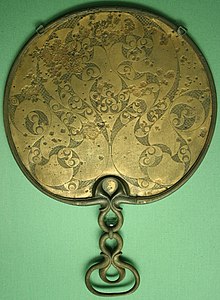
Back Arte celta AN فن كلتي Arabic Arte celta AST Кельцкае мастацтва Byelorussian Келтско изкуство Bulgarian Arz kelt Breton Art celta Catalan Keltské umění Czech Keltisk kunst Danish Keltische Kunst German


Celtic art is associated with the peoples known as Celts; those who spoke the Celtic languages in Europe from pre-history through to the modern period, as well as the art of ancient peoples whose language is uncertain, but have cultural and stylistic similarities with speakers of Celtic languages.
Celtic art is a difficult term to define, covering a huge expanse of time, geography and cultures. A case has been made for artistic continuity in Europe from the Bronze Age, and indeed the preceding Neolithic age; however archaeologists generally use "Celtic" to refer to the culture of the European Iron Age from around 1000 BC onwards, until the conquest by the Roman Empire of most of the territory concerned, and art historians typically begin to talk about "Celtic art" only from the La Tène period (broadly 5th to 1st centuries BC) onwards.[1] Early Celtic art is another term used for this period, stretching in Britain to about 150 AD.[2] The Early Medieval art of Britain and Ireland, which produced the Book of Kells and other masterpieces, and is what "Celtic art" evokes for much of the general public in the English-speaking world, is called Insular art in art history. This is the best-known part, but not the whole of, the Celtic art of the Early Middle Ages, which also includes the Pictish art of Scotland.[3]
Both styles absorbed considerable influences from non-Celtic sources, but retained a preference for geometrical decoration over figurative subjects, which are often extremely stylised when they do appear; narrative scenes only appear under outside influence.[4] Energetic circular forms, triskeles and spirals are characteristic. Much of the surviving material is in precious metal, which no doubt gives a very unrepresentative picture, but apart from Pictish stones and the Insular high crosses, large monumental sculpture, even with decorative carving, is very rare. Possibly the few standing male figures found, like the Warrior of Hirschlanden and the so-called "Lord of Glauberg", were originally common in wood.
Also covered by the term is the visual art of the Celtic Revival (on the whole more notable for literature) from the 18th century to the modern era, which began as a conscious effort by Modern Celts, mostly in the British Isles, to express self-identification and nationalism, and became popular well beyond the Celtic nations, and whose style is still current in various popular forms, from Celtic cross funerary monuments to interlace tattoos. Coinciding with the beginnings of a coherent archaeological understanding of the earlier periods, the style self-consciously used motifs closely copied from works of the earlier periods, more often the Insular than the Iron Age. Another influence was that of late La Tène "vegetal" art on the Art Nouveau movement.
Typically, Celtic art is ornamental, avoiding straight lines and only occasionally using symmetry, without the imitation of nature central to the classical tradition, often involving complex symbolism. Celtic art has used a variety of styles and has shown influences from other cultures in their knotwork, spirals, key patterns, lettering, zoomorphics, plant forms and human figures. As the archaeologist Catherine Johns put it: "Common to Celtic art over a wide chronological and geographical span is an exquisite sense of balance in the layout and development of patterns. Curvilinear forms are set out so that positive and negative, filled areas and spaces form a harmonious whole. Control and restraint were exercised in the use of surface texturing and relief. Very complex curvilinear patterns were designed to cover precisely the most awkward and irregularly shaped surfaces".[5]
- ^ Megaws, for example; see their introductory section, where they explain the situation & that their article will only cover the La Tène period.
- ^ "Technologies of Enchantment: Early Celtic Art in Britain". British Museum. Archived from the original on 2012-08-04. It is also used by Jacobsthal; however the equivalent "Late Celtic art" for Early Medieval work is much rarer, and "Late Celtic art" can also mean the later part of the prehistoric period.
- ^ Laings, 6–12
- ^ Megaws
- ^ Johns, 24